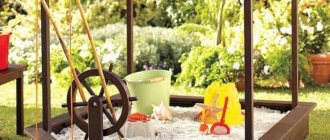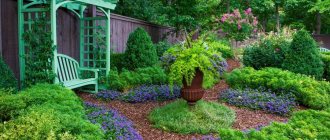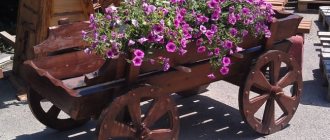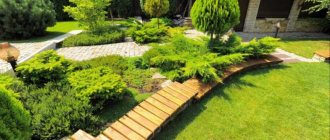Have you ever encountered a situation where there was building material left at your dacha or village and there was nowhere to use it? Are you familiar with the piles of boards or clapboards near your shed or workshop?
It is in such a situation that a light bulb goes on inside the summer residents: “It’s time to use this material and build something.” Subsequently, this available material turns into a gazebo (or part of it - roof, walls, floor).
Wooden gazebo made of straw
There are a lot of options for available materials. There are even more ideas for construction.
This article will look at examples of village and country gazebos built from ordinary materials that were left at the dacha after some large-scale construction, or simply lay there as “dead weight” for several years.
Amateur summer residents have long realized that a roof can be made from straw, a foundation can be made from the remaining tiles, and a full-fledged gazebo can be built from pallets. More photo ideas later in the publication.
Made of wood
Wooden gazebos are the cheapest in price and simple to construct. Combined with construction on your own and using scrap materials, you get almost free construction, which you just need to spend time on.
That is why, first of all, the option made of wood is considered.
By adding decorative wood carvings, you get a very beautiful and simple gazebo
Made of wood
Wooden gazebo
Tree
Made from dark wood
Board
Most often, it is the boards that are left at the dacha or brought from somewhere from work. This is the cheapest, most popular and used material for building gazebos. With their help, you can sheathe walls, lay floors and even build a roof. Several options are presented below.
Usually, the boards remain after the arrival of other building materials, since many goods are stored and transported on them.
timber
The timber is used for the frame of the gazebo - the bottom frame, pillars and rafter system. If you have access to similar raw materials that are suitable in length and quality, then you already have most of the building.
Sheathing a structure is not as difficult as building the foundation itself, and this is precisely what timber is suitable for.
Pallets
The topic of pallets is generally “wildly” popular. We even opened special points for the purchase/sale of pallets in Penza and the Penza region.
The most interesting thing is that they make quite tolerable buildings, provided the material is of sufficient quality. It is enough to carefully separate the boards with a hammer and crowbar, process them, let them dry and you can “create”. The ideal option would be dry, smooth and white boards.
If dry cargo was stored on pallets, and they are not particularly worn out by time, then they are perfect for construction.
Wicker from branches
Designs made from thin twigs and branches that form a wicker gazebo look aesthetically pleasing. Thanks to this weaving, it is possible to shelter the room from the sun, but at the same time people will be in the fresh air and not sweat inside from the heat.
This type of gazebo is rarely found in dachas, but it looks very civilized and beautiful.
Lay the foundation
stroyfora.ru
Without a solid foundation, only purchased gazebos with a tubular frame and an awning covering can be used. For everyone else, you need at least a light foundation.
Since the weight of such buildings is small, the use of monolithic and strip foundations is impractical. A columnar foundation is optimal. It is suitable for all types of gazebos, except brick ones.
Proceed like this:
- Mark the perimeter of the future building. Mark the locations of the corner, intermediate and central pillars. The distance between them should be 1.5–2 m.
- Dig or drill holes 0.5–0.8 m deep. Place and compact a layer of crushed stone at the bottom of each hole. Then a layer of sand, which is also compacted.
- Make formwork 20–25 cm high from boards, plywood or sewer pipes to form the above-ground part of the posts.
- Pour out the concrete pillars. For strength, place reinforcement inside. If desired, you can install threaded anchors for convenient fastening of the lower harness.
Polycarbonate
Polycarbonate slabs are a favorite material for summer residents. Most likely, you don’t have one at your dacha. However, the low price will allow you to purchase it inexpensively and use it for construction. It is quite suitable for combination with wood or metal, that is, the material at hand for your dacha.
Sometimes pieces of polycarbonate are left over after creating a greenhouse (they have become very popular recently), they can also be used as a handy construction resource.
Preparation of logs
In order to make the “logs” from bottles as strong as possible, it is necessary to cut off the bottom of the container and drive the next bottle into the resulting cavity - with the neck inward.
This should be done with force, for the strongest possible adhesion of the elements. To increase the reliability of the design, you can stitch the bottles with wire. Of course, this should not be done at the expense of the visual appeal of the overall design.
Made of brick
At most dachas, there are always several dozen bricks in the inventory room, cellar or barn. This is a distinctive feature of a standard dacha. No one can remember where it came from and how long it has been there, however, the very fact of its presence is very pleasing.
The initial raw materials for construction are already available, and if it is possible to get more, you can completely think about building a full-fledged brick gazebo.
In addition to bricks, for construction you will need cement, sand, crushed stone, reinforcement and a source of water. Don’t forget about the roof, since sculpting cheap polycarbonate onto a brick building will somehow be too “collective farm”.
Base for lightweight construction
First of all, a gazebo project is drawn up, which includes a list of materials used, an indication of the installation location of the structure, as well as a drawing with exact dimensions. A detailed project will not allow you to make mistakes during construction. You can make it yourself, taking the idea from the photographs presented.
The procedure for carrying out construction work:
- dig holes for piles or a trench for a strip foundation;
- formwork is made along the edges;
- a layer of sand 15 cm thick is poured onto the bottom;
- pour concrete mixed with construction waste - crushed stone, small stones, brick fragments;
- The base is covered with film so that the water from the solution does not evaporate too quickly.
It will take a month for the foundation to gain strength. The hardened concrete is treated with waterproofing material. After this, they begin to form the lower trim - the base for fixing the frame elements and the floor. The harness is made of metal or wood, even if the frame is made of plastic. The exception is a brick gazebo, in which case the brick is placed directly on the foundation.
Photo: attaching the harness to a columnar foundation
The strapping is done around the perimeter of the future gazebo. Using steel corners or the dovetail method, wooden logs are attached to it, on which floorboards made of natural wood or wood-polymer composite are placed.
Made of metal
It’s unlikely that you have several dozen iron pipes and rods lying around on your site, along with a welding machine, electrodes and a great desire to create a metal gazebo with decorative forging.
Steel gazebos are quite expensive, so I wouldn’t count on the fact that you have all the material at your dacha (I’m not even talking about the ability and desire to build such structures).
However, it is quite possible that you have posts that can be used to create a frame. In tandem with cheap polycarbonate, you can create a very good gazebo using only available materials for construction.
It is not necessary to use a lot of iron to create a metal gazebo. Four pillars will be enough to set the base, and it will be complemented by polycarbonate or any other material from which the roof and cladding can be made.
You may need to make a stronger foundation if you cannot, due to the lack of additional metal, make the gazebo solid.
Choosing the size and shape
Even before starting construction, it is important to determine exactly what size gazebo you are planning.
Large structures can be used as a summer kitchen. For these purposes, it is necessary to provide a stove and a place for cooking and storing food.
A smaller gazebo can have a place for a barbecue or barbecue, a table and seating.
Very small buildings can be a resting place for one person. A rocking chair or a hammock would look very natural there. It is equally important to determine the shape of the future gazebo. In modern construction there are three options:
- A gazebo in the shape of a polygon (usually a hexagon or octagon).
- A gazebo in the shape of a rectangle (the easiest option for self-construction).
- A gazebo in the shape of a circle (this is an almost completely open version, made of highly flexible material).
Non-standard building materials
From the “Do it yourself” section. There are a huge number of things that can be used for construction. This collection contains quite unique materials that are used to build a gazebo.
Using bamboo
Some of them frankly look flawed. I wouldn’t put such creations on my site, but in some cases they are quite applicable and fulfill their function - a place for people to relax, eat, children play, etc.
Bottles
You have to be a summer resident to the core to dare to build a gazebo out of plastic bottles. There are several approaches to how the building should look after its construction is completed, but in general everything is clear from the photographs attached below.
Thanks to the air inside, bottles are an excellent thermal insulation material.
There is an example when glass bottles were used as an alternative to brick - they were also laid in layers on the mortar, after which the walls were puttied and leveled.
This design seems very unreliable to me. I don’t know the correct technology for laying bottles so that they don’t break under the weight of the top layers.
Window frames
The main expense during the construction of a gazebo goes to the cladding. Thanks to old window frames, you can close the structure on all sides as much as possible, and then cover it with wood for beauty, if it is available.
One way or another, the option is very workable and is actively used by summer residents.
Plants
Plants can only be called a “construction” resource in part, because in this context they grow on their own.
With the right approach, climbing plants can completely envelop the gazebo, thereby protecting it from the sun, wind and even rain. This will allow you to achieve an ecological and interesting building that will delight you and your guests, neighbors and friends.
The idea of a living metal gazebo
Natural flowers
True, there is one obvious drawback - for the base, again, you need material, for example, wooden blocks or metal pipes. Growing plants is not such a big problem, but choosing and preparing a place is where difficulties arise.
What type of gazebo to choose?
The main place for family meetings on cozy evenings in the garden is the gazebo. There are the following types that you can easily build yourself:
- Open. This is a system of posts around the entire perimeter that supports a lightweight roof. Most often, the frame is made of metal rods or wood.
- Closed. Small houses with windows and doors that allow you to use small garden architecture all year round in any weather.
In a closed gazebo you can organize a full-fledged summer kitchen. Choose a design depending on the size of the site. A closed structure is more suitable for large areas because it looks quite massive. Open - ideal for any size yard. Thanks to its lightness and airiness, it does not clutter up the space. Semi-open pergolas with several walls and a roof are popular. A frame decorated with climbing plants will create shade and coolness inside. Choose a variety of climbing roses, lush flowers that provide color throughout the summer.











